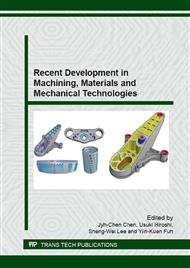p.694
p.700
p.706
p.712
p.719
p.725
p.729
p.735
p.741
Testing and Improvement of Static Performance of Proximity Sensor for a Mobile Robot
Abstract:
In recent years, mobile robot is one of the most interesting topics attracting scientists and factories. With breakthrough techniques in sensor, we can control a mobile robot more reliably. Besides, measuring at static state of the inductive proximity sensor is also necessary since the detective and navigation systems perform more accurately by information from the experiment by analyzing the signal. The purpose of this paper, the hand-made measurement system is used to verify the static performance with the type of aluminium and analyse the relationship between the output signal and the position of the sensor. All we know that the relationship of the static parameters can be determined such as: sensing distance, dimension of material, thickness of material, and so on. The measured data have shown the output signal of proximity sensor in the model and theory which is not identical. The results will provide some information about the different effects of position sensor and optimum operating range of a mobile robot. In addition, by comparing the results achieved, giving solutions to enhance the static performance of the proximity sensor for a mobile robot, such as: choosing of material thickness ranges which is suitable for the operation of a mobile robot, setting the proper sensing distance to be the most stable. This research aims to provide a secure and accurate signal for the control of mobile robots.
Info:
Periodical:
Pages:
719-724
Citation:
Online since:
July 2015
Authors:
Price:
Сopyright:
© 2015 Trans Tech Publications Ltd. All Rights Reserved
Share:
Citation:


